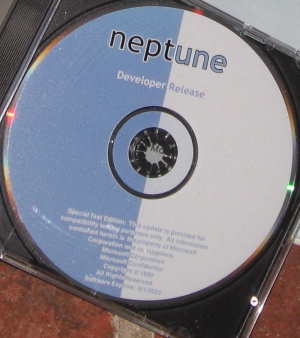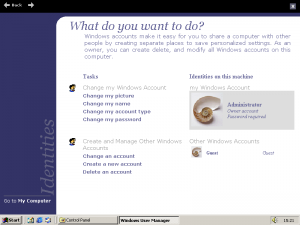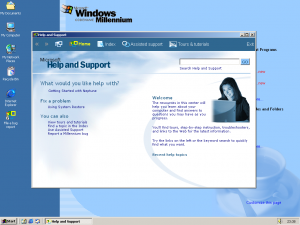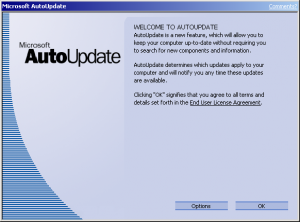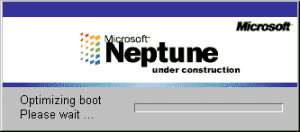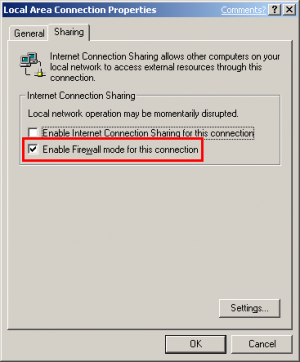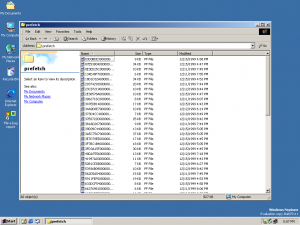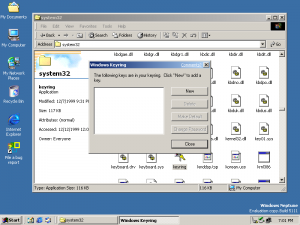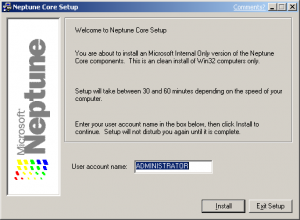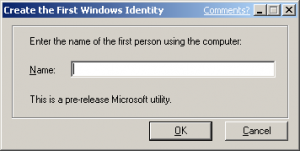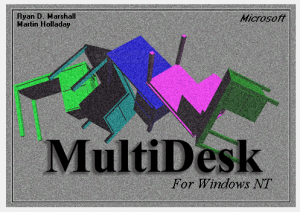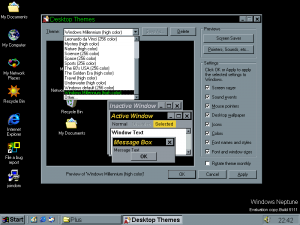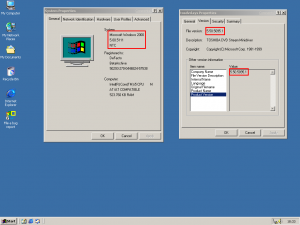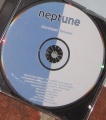m (→onetouch.exe) |
No edit summary Tag: 2017 source edit |
||
| (107 intermediate revisions by 17 users not shown) | |||
| Line 1: | Line 1: | ||
{{ | {{Infobox Buildinfo | ||
|title = 5.5.5111.1 | |||
|image = 5111about.png | |image = 5111about.png | ||
|imagecaption = | |imagecaption = System Properties and About Windows | ||
|kernel = NT 5. | |status = Released (Developer) | ||
|arch= x86 | |kernel = NT 5.00 (in screenshot) | ||
| | |arch = x86 | ||
| | |sku = Consumer | ||
| | |compiled = 10 December 1999 | ||
|bios = N/A | |||
|timebomb = 444 days | |||
|key = W7XTC-2YWFB-K6BPT-GMHMV-B6FDY | |||
|betawiki = [https://betawiki.net/wiki/Windows_Neptune_build_5111 Available] | |||
|tcb = [https://thecollectionbook.info/builds/windows/build/220 Available] | |||
}} | }} | ||
'''Windows Neptune build 5111''' is a Developer Release of [[Windows Neptune]] and a Milestone 2 build. At the moment, it is the only leaked build of Microsoft Neptune, though other builds are rumoured to exist. | |||
== Installation == | == Installation == | ||
The copy available on the BetaArchive FTP server is | The copy available on the BetaArchive FTP server is bootable, but requires a key and has a timebomb. It appears to be the original copy that was distributed to private testers. | ||
Another | Another copy is available on the internet, but it's de-timebombed and doesn't require a key. | ||
A clean installation is recommended, but upgrading from Windows 2000 and Windows 98 is also possible. | |||
The explorer in Neptune is often quoted as being a problem in Neptune, and is blamed for the slow startup on the first boot. The reason for the apparent hanging at first boot, is that a broken still image service is trying to startup, before explorer is loaded. Fixing or otherwise stopping the service from running should fix the slow startup. | The explorer in Neptune is often quoted as being a problem in Neptune, and is blamed for the slow startup on the first boot. The reason for the apparent hanging at first boot, is that a broken still image service is trying to startup, before explorer is loaded. Fixing or otherwise stopping the service from running should fix the slow startup. | ||
=== Setup Upgrade Bug === | === Setup Upgrade Bug === | ||
[[File:Neptune 5111 CD.jpg|thumb]] | |||
Inserting a Windows Neptune disc into a Windows XP computer will show a message saying "This CD-ROM contains a newer version of Windows than the one you are presently using. Would you like to install Neptune?" | Inserting a Windows Neptune disc into a Windows XP computer will show a message saying "This CD-ROM contains a newer version of Windows than the one you are presently using. Would you like to install Neptune?" Same happens when you insert the disc into an already installed Neptune. | ||
This might be because | This might be because Neptune's version is 5.50.5111, while XP's is 5.10.2600. | ||
=== Key / Timebomb === | === Key / Timebomb === | ||
Most of the leaked ISO images have had their timebombs nulled and don't require a key, | Most of the leaked ISO images have had their timebombs nulled and don't require a key. However, the copy available on the BetaArchive FTP server will accept the following key ''W7XTC - 2YWFB - K6BPT - GMHMV - B6FDY'' or any Windows 98 (SE) retail keys (not MSDN, OEM or upgrade). The copy available on the BetaArchive FTP server has a timebomb of 444 days. | ||
== Features == | == Features == | ||
=== Activity Centers === | |||
The [[Activity Centers]]' main layouts are contained in the "ACCORE.DLL" ('''A'''ctivity '''C'''enter '''CORE'''.DLL), which is used to tie all the activity center resources together via the html layout extracted when the dll is registered (see the instructions below). | |||
The Start page in 5111 was meant to be used as an Active Desktop page, otherwise it displays errors when trying to customise it. | |||
The Photo Center is powered by an overhauled Image Acquisition service. This registry entry allows the service to work:<ref name="AlbacoreImage Acquisitionreg">{{cite web | author = Albacore (@thebookisclosed) | title = Luckily, creating the link does not seem to have negative impact on system functionality (from my limited testing) Here's the .reg if you wish to try this | url = https://twitter.com/thebookisclosed/status/1315710041719279616 | publisher = Twitter | date = 13 October 2020 |accessdate = 17 April 2022}}</ref><ref name="AlbacoreImage Acquisition">{{cite web | author = Albacore (@thebookisclosed) | title = One of the things powering the Neptune Photo Activity Center was an overhauled Image Acquisition service. Unfortunately, in build 5111 it always hangs on start, and so does Photo Center as a result. After patching up relevant COM security settings, the service springs to life! | url = https://twitter.com/thebookisclosed/status/1315705529063403521 | publisher = Twitter | date = 13 October 2020 |accessdate = 17 April 2022}}</ref> | |||
<code>Windows Registry Editor Version 5.00 | |||
[HKEY_CLASSES_ROOT\AppID\svchost.exe] | |||
"AppId"="{A1E75357-881A-419E-83E2-BB16DB197C68}"</code> | |||
==== Installing Activity Centers ==== | |||
To install the Activity Centers in this build, follow these instructions: | |||
*Put your Neptune installation CD into your CD drive. | |||
*Navigate to '''My Computer > X:\I386''' (X is your CD drive letter) | |||
*Copy the file '''accore.dll''' to '''Y:\WINNT\System32''' (Y is your Windows partition letter) | |||
*Click '''Start''', '''Run''' or press '''Windows Key + R''' to open the '''Run''' dialog. | |||
*Type in '''''regsvr32 accore.dll''''' and press '''Enter'''. | |||
*Now you can find the files in '''%WINDIR%\Activity'''. | |||
You can set the activity centers as a background, as it is probably meant to be, by doing the following: | |||
*Right click the desktop, click properties and go to the Web tab. | |||
*Put a tick in the box with: Show Web content on my Active Desktop. | |||
*Click the "New" button and browse to the activity center's main homepage ('''%WINDIR%\Activity\Start\StartPage\start.htm'''). | |||
*Maximize the new screen at the desktop by hovering over the top with your mouse and clicking the second right button. | |||
*'''Optional:''' Remove the icons by right clicking in the empty space on the desktop, hovering over "Active Desktop" and clicking "Show Desktop Icons". Then place your mouse over the left border and stretch it as far left as possible or click the third right button. | |||
After many years, extensive file edits, lots of research as well as trial and error, ex-BA member KenOath was able to fix the Activity Centers close to what Microsoft intended. | |||
=== Login Screen === | === Login Screen === | ||
The '''Login Screen''' in Neptune is an HTML and JavaScript based UI. The Login Screen files can be found in '''logonhta.dll'''. Installing Internet Explorer 6 on this build usually causes the login screen to stop functioning, as well as some other issues. | |||
The '''Login Screen''' in Neptune is an HTML and JavaScript based UI. The Login Screen files can be found in '''logonhta.dll'''. Installing Internet Explorer 6 on this build usually causes the login screen to stop functioning. | |||
On the top you can see the classic Windows logo and the word "Welcome" below it. Further down the page, a list of all accounts is displayed. On the bottom left is a shortcut for shutting down the computer (which, by default, triggers hibernation). Hovering over it, while holding SHIFT will change it into a restart shortcut and holding down CTRL will change the text into "Completely shutdown the computer" (this one does what it says). The computer's name is displayed on the bottom right. | |||
The Login screen displays a user picture for each user on the system that can be changed via the User Accounts Panel. | An improved version of this login screen also appears in various builds of Windows Whistler (released as XP), first in build 2211, but it's not enabled by default. At some point later on, the login screen became DirectUI-based and was changed significantly. | ||
The Login screen also displays a user picture for each user on the system, that can be changed via the User Accounts Panel. By default, Neptune includes 10 pictures, but users can also browse for more. | |||
=== User Accounts === | === User Accounts === | ||
| Line 49: | Line 89: | ||
* Child - This type of account is intended for children whose activity should be monitored and who should be safeguarded against corrupting computer settings and deleting important system files. Restricted accounts have limited access to internet content and can have limited computer time. A person with a child account can only change his or her own account name and picture. | * Child - This type of account is intended for children whose activity should be monitored and who should be safeguarded against corrupting computer settings and deleting important system files. Restricted accounts have limited access to internet content and can have limited computer time. A person with a child account can only change his or her own account name and picture. | ||
* Guest - | * Guest - This type of account is intended for Guests to use the computer. Guest accounts have restricted access to this computer. Settings, Themes and web browsing history will be erased each time a person with a guest account turns off the computer. Only Documents created by a guest person will be saved. | ||
==== User Accounts Panel ==== | ==== User Accounts Panel ==== | ||
[[File:Useraccountmnger_5111.PNG|thumb]] | [[File:Useraccountmnger_5111.PNG|thumb]] | ||
Officially known as "Windows Identities", this is yet another HTML and JavaScript based application, pretty much an early version of the Windows XP user accounts manager. Interestingly, it seems that the wording and layout did not change much even upto the RTM of XP. The source code for the applet is contained in '''nusrmgr.cpl'''. | |||
The source code for the applet is contained in '''nusrmgr.cpl'''. | |||
=== Help Center === | === Help Center === | ||
[[File:Helpsupport_5.5.5111.png|thumb]] | [[File:Helpsupport_5.5.5111.png|thumb]] | ||
The '''Help Center''' in this build appears to be a direct copy from an early [[ | The '''Help Center''' in this build appears to be a direct copy from an early [[Windows ME]] build, as the internal branding and help text often contains references to "Windows Millennium". It is run by MSHTML and uses '''.htm''' and '''.xml''' files for most of the content, as can be seen in the data folder <code>C:\WINNT\PCHealth\HelpCtr\System</code>. | ||
There is an intentionally commented out Windows 2000 Help Link (same help as the Windows 2000 RTM) in the '''homepage.htm''' code and the system restore Link points to a missing EXE in the winnt directory. | There is an intentionally commented out Windows 2000 Help Link (same help as the Windows 2000 RTM) in the '''homepage.htm''' code and the system restore Link points to a missing EXE in the winnt directory. | ||
The database is a '''.mdb''' file and can be edited with Microsoft Access (after Whistler 2202, Microsoft switched to a different file format that doesn't allow easy editing); copying the database from early [[ | The database is a '''.mdb''' file and can be edited with Microsoft Access (after Whistler 2202, Microsoft switched to a different file format that doesn't allow easy editing); copying the database from early [[Windows ME]] builds should add the full range of support topics, however some broken help links will show up. | ||
Using the '''HCupdate.exe''' in the '''binary''' folder and a properly configured '''.cab''' file allows updates to the Help Center | ==== Help Center Data Update ==== | ||
Using the '''HCupdate.exe''' in the '''binary''' folder and using the ''Cabarc.exe'' from the MS Cab SDK to create a properly configured '''.cab''' file allows updates to the Help Center database. | |||
==== Bug Reporting ==== | ==== Bug Reporting ==== | ||
The bug reporting is launched via the "Help And Support Center" and is not linked to on the start menu, like most of the other HTML based apps it appears to be from [[Windows ME]], as much of the branding still says "Windows Millennium". In this case, the bug reporting page itself is from Millennium build 2408, and the readme is from 2404. | |||
The bug reporting is launched via the "Help And Support Center" and is not linked to on the start menu, like most of the other HTML based apps it appears to be from | |||
There are two ways of launching the report a bug, one is via the desktop shortcut "Report a Bug" and the other is to click on the Comments link on the top of every dialogue/window. | There are two ways of launching the report a bug, one is via the desktop shortcut "Report a Bug" and the other is to click on the Comments link on the top of every dialogue/window, though the second option displays a dedicated dialog, rather then the Help Center page. | ||
Creating a bug report still | Creating a bug report still creates a cab file in the root of C:, however the reporting servers have been shutdown/re-purposed years ago. The source code of the page is in the file "bugrep.htm" in the vendor folder. | ||
The page | |||
Bugrep.htm contains 2 commented out sections "Direct X Team" & "System Restore Team", containing extra steps to diagnose issues. | |||
=== AutoUpdate === | |||
=== | |||
[[File:neptuneauclient.PNG|thumb]] | [[File:neptuneauclient.PNG|thumb]] | ||
Microsoft Autoupdate in Neptune is hidden away in the C:\WINNT directory named wuauclt.exe (That could stand for '''W'''indows '''U'''pdate '''A'''uto '''U'''pdate '''C'''lien'''t'''). Copied directly from a [[ | Microsoft Autoupdate in Neptune is hidden away in the C:\WINNT directory named wuauclt.exe (That could stand for '''W'''indows '''U'''pdate '''A'''uto '''U'''pdate '''C'''lien'''t'''). Copied directly from a [[Windows ME]] build this application was to form a part of the Automatic Updates. | ||
This is another example of a typical HTML application in Neptune. The UI code is stored in '''wuauhtml.dll'''. | |||
This is another of | |||
=== Mars / Mars.exe === | === Mars / Mars.exe === | ||
An executable with this name can be found in every leaked Millennium build, as well as Neptune. In early Millennium builds, the icon is a blue lower-case "m" on white background. Later on, it was changed to a yellow square smiley (";)") with black borders. The ProducName description states "Microsoft(R) Mars (R) Communications System". | |||
Mars.exe serves as the framework (hence, the name "Mars Framework") for running web pages as framed applications. It also runs the [[#User Accounts Panel|User Accounts Panel]] and the [[#Login Screen|Login Screen]].<ref name = "Ken">{{cite web | |||
|author=Ken | |||
Mars. | |title=Re: Windows Mars in Windows Neptune | ||
|url=https://www.betaarchive.com/forum/viewtopic.php?p=150455#p150455 | |||
|publisher=BetaArchive | |||
|date=12 May 2010 | |||
|accessdate=8 April 2022}}</ref> Mars uses the XML file in the folder of an Activity Center as the page's main layout. The <code>msjava.dll</code> also appears to be the number one dependency of this app, which Ken found when fiddling around | |||
with various msjava installations to get the Game Center working.<ref name = "Ken1">{{cite web | |||
|author=Ken | |||
|title=Re: Windows Mars in Windows Neptune | |||
|url=https://www.betaarchive.com/forum/viewtopic.php?p=164825#p164825 | |||
|publisher=BetaArchive | |||
|date=28 July 2010 | |||
|accessdate=8 April 2022}}</ref> | |||
Mars exists in retail [[Windows XP]]. The file <code>marscore.dll</code> (called "Mars"core because Mars was its beta name) has been renamed to <code>pchshell.dll</code> - which is "PC Health Shell". The pictures below show that the GUId and contents of pchshell from XP and the marscore from Neptune are the same. The only difference is that the Neptune version has an XML validator built into it.<ref name = "Ken" /> | |||
<gallery> | <gallery> | ||
Pcshell marscore.png|Windows XP PCSHell | |||
Neptune_marscore.png|Neptune Mars Core | |||
</gallery> | </gallery> | ||
=== | === Fast Boot === | ||
[[File:Neptunebootopt.png|thumb]] | |||
Fast boot appears in the Power Options Control Panel, but is only available if you install Neptune on a FAT formatted partition. On the next reboot Neptune optimizes the boot. Upon investigation of this feature, it appears that after enabling the option for Fast Boot, a sub-directory in the WINNT directory is created, called "boot", and a 2.4MB file is created, called 'bootimg.img'. The file contents appear to be an initial memory snapshot of the boot drivers and kernel. Further investigation is needed to see exactly how the bootloader uses this data. Even with this newly-found information, it is unknown what exactly this process actually does. It appears to be a yet another Neptune feature that wasn't included in XP. The feature is contained within ''fastbike.dll''. | |||
=== Firewall === | |||
[[File:Neptune_firewall.png|thumb]] | |||
Neptune also seems to include a firewall, though it's very limited. There appears to be no settings interface and the only trace of this feature (which later made it's way into the RTM release of Windows XP) is a checkbox on each network connection's property page. | |||
==== | === Other Notes === | ||
==== My Pictures Screensaver ==== | |||
Neptune included this screensaver before it was also added in XP. It isn't included with Windows 2000, and it's the only one with version number 5.5 5111, the rest of them are 5.0 2090.1 | |||
==== Prefetch==== | |||
Neptune has a Prefetch folder like XP, and it does the same that it does on XP, but the folder is in System32. | |||
[[File:neptuneprefetch.png|thumb]] | |||
==== Branding ==== | |||
The branding in Neptune is inconsistent and incomplete. The setup, bootscreen and other new features say "Microsoft Neptune", while the rest of the OS still states "Windows 2000" (or Millennium in case of Activity Centers). This is understandable though, as the build is just in Milestone 2 stage and most of the UI is yet to be completed/updated. | |||
The bootscreen is a direct copy of Windows 2000's bootscreen with slight changes, the most obvious being the new Neptune logo. The progress bar and sliding gradient image are also slightly different. | |||
==== keyring.exe ==== | |||
This program is in the system32 folder. | |||
[[File:5111k.png|thumb]] | |||
==== onetouch.exe ==== | |||
====onetouch.exe==== | |||
[[File:Neptunecoresetup.PNG|thumb]] | [[File:Neptunecoresetup.PNG|thumb]] | ||
This EXE is included on the windows Neptune CD with the title "Neptune Core Setup". | This EXE is included on the windows Neptune CD with the title "Neptune Core Setup". | ||
It | It looks as it was meant to download the latest Neptune files from a Microsoft server and proceed to install Neptune as an upgrade. | ||
Many of the internal strings point this to being some kind of unattended setup program: | Many of the internal strings point this to being some kind of unattended setup program: | ||
| Line 148: | Line 182: | ||
[[File:Unattendneptune_core_5111.PNG]] | [[File:Unattendneptune_core_5111.PNG]] | ||
====joindom.exe==== | ==== joindom.exe ==== | ||
[[File:Neptunoobe2.PNG|thumb]] | [[File:Neptunoobe2.PNG|thumb]] | ||
joindom.exe is set to start on first boot and is | joindom.exe is set to start on first boot and is an internal pre-release Microsoft utility that sets up the first user name and appears to be part of an Out-of-box Experience. <br> | ||
[[File:Neptunoobeprerel.PNG]]<br> | [[File:Neptunoobeprerel.PNG]]<br> | ||
Interestingly, the file version information points to it being a part of an upgrade setup. | Interestingly, the file version information points to it being a part of an upgrade setup. | ||
[[File:Neptuneupgrade.PNG]] | [[File:Neptuneupgrade.PNG]] | ||
====multidsk.exe==== | ==== multidsk.exe ==== | ||
[[File:Neptune Multidesk.PNG|thumb]] | [[File:Neptune Multidesk.PNG|thumb]] | ||
This is a file found in the | This is a file found in the i386 folder on the Neptune disk allows usage of multiple desktops (similar to many Linux based operating systems) and has the annoying habit of logging you off if you exit the program. First included in the Microsoft Windows NT 4.0 Resource Kit. | ||
==== themes.exe ==== | |||
[[File:Neptunethemes2.PNG|thumb|Windows ME Theme files copied to Neptune]] | |||
This file is found in the System32 folder. Copying the Plus! Pack themes from a Windows ME computer or the Windows 98 Plus! Pack and browsing to them allows basic (Windows ME/98) themes to be set in Neptune. | |||
==== Build 5095.1 ==== | |||
====Build 5095.1==== | |||
[[File:Build5095.1.png|thumb|A file from Neptune build 5111.1 with version number 5.50.5095.1]] | [[File:Build5095.1.png|thumb|A file from Neptune build 5111.1 with version number 5.50.5095.1]] | ||
There is a file (tosdvd.sys) in Neptune build 5111.1 that has a version number 5.50.5095.1 and could | There is a file (<code>tosdvd.sys</code>) included in Neptune build 5111.1, that has a version number of 5.50.5095.1 and could be a leftover from an earlier Neptune build, however, it is unknown if Neptune build 5095.1 ever existed. | ||
==== Neptune Server ==== | |||
Some of the setup files in Neptune build 5111.1 contain references to "Neptune Server", but it is unknown if it is a typo or if the SKU ever existed. | |||
== Gallery == | |||
<gallery> | |||
Boot Screens Windows Neptune.png|Boot screen | |||
Neptune build 5111.1 Setup 29.png|Logon screen | |||
WinNeptune5111.png|First boot | |||
Neptune build 5111.1 Setup 22.png|User accounts panel | |||
Helpsupport_5.5.5111.png|Help and support | |||
Activitycenter_5.5.5111.jpg|Activity center | |||
neptuneauclient.PNG|AutoUpdate | |||
5111k.png|keyring.exe | |||
neptuneprefetch.png|Prefetcher | |||
Neptune 5111 CD.jpg|Disc | |||
</gallery> | |||
== | == References == | ||
< | <references /> | ||
== See | == See also == | ||
* [http:// | * [http://winsupersite.com/article/product-review/the-road-to-gold-the-development-of-windows-xp-reviewed Windows XP: Road to gold - Paul Thurrott, 24-08-2001] | ||
* [ | * [[File:Antitrust_PX07297.pdf|Microsoft Anti-Trust Court Documents]] | ||
* [http://www.beige-box.com/nttalk-5111.txt AlphaChat #nttalk - NEPTUNE M2] | * [http://www.beige-box.com/nttalk-5111.txt AlphaChat #nttalk - NEPTUNE M2] | ||
[[ | === BetaArchive forum === | ||
[[ | * [[forum:2900|Im Trying to Fix Neptune's Activity Center :D]] | ||
* [[forum:3075|[Found] "Neptune Project"]] | |||
* [[forum:3189|Neptune's Activity Center...]] | |||
* [[forum:4274|Hidden feature in Microsoft Neptune]] - AutoUpdate | |||
* [[forum:13471|Neptune Activity Center Vid *Trimmed down*]] | |||
* [[forum:13620|Windows Neptune suprise]] - build number 5111 causes XP (build number 2600) to recognize Neptune as a newer Windows OS | |||
* [[forum:30877|Windows Neptune Build 5111]] | |||
* [[forum:30265|"MARS.EXE" Question Neputne 5111]] | |||
* [[forum:32190|Neptune Activity Center Problem]] | |||
* [[forum:32192|Discovery in 5111]] - Windows Keyring | |||
* [[forum:32455|Neptune Activity Center (by KenOath)]] | |||
* [[forum:33595|Windows Neptune Activity Centers Working in WindowsME & 2419]] | |||
* [[forum:37427|Windows Neptune Only Running in 16-color Mode]] | |||
* [[forum:40648|Is Neptune 5111 on the FTP original?]] | |||
Latest revision as of 14:46, 7 November 2023
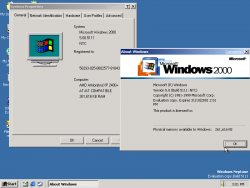 |
|
| System Properties and About Windows | |
| Status | Released (Developer) |
|---|---|
| Kernel version | NT 5.00 (in screenshot) |
| CPU architecture | x86 |
| Edition | Consumer |
| Compile date | 10 December 1999 |
| BIOS date | N/A |
| Timebomb | 444 days |
| Product key | W7XTC-2YWFB-K6BPT-GMHMV-B6FDY |
| BetaWiki | Available |
| TCB | Available |
Windows Neptune build 5111 is a Developer Release of Windows Neptune and a Milestone 2 build. At the moment, it is the only leaked build of Microsoft Neptune, though other builds are rumoured to exist.
Installation
The copy available on the BetaArchive FTP server is bootable, but requires a key and has a timebomb. It appears to be the original copy that was distributed to private testers.
Another copy is available on the internet, but it's de-timebombed and doesn't require a key.
A clean installation is recommended, but upgrading from Windows 2000 and Windows 98 is also possible.
The explorer in Neptune is often quoted as being a problem in Neptune, and is blamed for the slow startup on the first boot. The reason for the apparent hanging at first boot, is that a broken still image service is trying to startup, before explorer is loaded. Fixing or otherwise stopping the service from running should fix the slow startup.
Setup Upgrade Bug
Inserting a Windows Neptune disc into a Windows XP computer will show a message saying "This CD-ROM contains a newer version of Windows than the one you are presently using. Would you like to install Neptune?" Same happens when you insert the disc into an already installed Neptune.
This might be because Neptune's version is 5.50.5111, while XP's is 5.10.2600.
Key / Timebomb
Most of the leaked ISO images have had their timebombs nulled and don't require a key. However, the copy available on the BetaArchive FTP server will accept the following key W7XTC - 2YWFB - K6BPT - GMHMV - B6FDY or any Windows 98 (SE) retail keys (not MSDN, OEM or upgrade). The copy available on the BetaArchive FTP server has a timebomb of 444 days.
Features
Activity Centers
The Activity Centers' main layouts are contained in the "ACCORE.DLL" (Activity Center CORE.DLL), which is used to tie all the activity center resources together via the html layout extracted when the dll is registered (see the instructions below).
The Start page in 5111 was meant to be used as an Active Desktop page, otherwise it displays errors when trying to customise it.
The Photo Center is powered by an overhauled Image Acquisition service. This registry entry allows the service to work:[1][2]
Windows Registry Editor Version 5.00
[HKEY_CLASSES_ROOT\AppID\svchost.exe]
"AppId"="{A1E75357-881A-419E-83E2-BB16DB197C68}"
Installing Activity Centers
To install the Activity Centers in this build, follow these instructions:
- Put your Neptune installation CD into your CD drive.
- Navigate to My Computer > X:\I386 (X is your CD drive letter)
- Copy the file accore.dll to Y:\WINNT\System32 (Y is your Windows partition letter)
- Click Start, Run or press Windows Key + R to open the Run dialog.
- Type in regsvr32 accore.dll and press Enter.
- Now you can find the files in %WINDIR%\Activity.
You can set the activity centers as a background, as it is probably meant to be, by doing the following:
- Right click the desktop, click properties and go to the Web tab.
- Put a tick in the box with: Show Web content on my Active Desktop.
- Click the "New" button and browse to the activity center's main homepage (%WINDIR%\Activity\Start\StartPage\start.htm).
- Maximize the new screen at the desktop by hovering over the top with your mouse and clicking the second right button.
- Optional: Remove the icons by right clicking in the empty space on the desktop, hovering over "Active Desktop" and clicking "Show Desktop Icons". Then place your mouse over the left border and stretch it as far left as possible or click the third right button.
After many years, extensive file edits, lots of research as well as trial and error, ex-BA member KenOath was able to fix the Activity Centers close to what Microsoft intended.
Login Screen
The Login Screen in Neptune is an HTML and JavaScript based UI. The Login Screen files can be found in logonhta.dll. Installing Internet Explorer 6 on this build usually causes the login screen to stop functioning, as well as some other issues.
On the top you can see the classic Windows logo and the word "Welcome" below it. Further down the page, a list of all accounts is displayed. On the bottom left is a shortcut for shutting down the computer (which, by default, triggers hibernation). Hovering over it, while holding SHIFT will change it into a restart shortcut and holding down CTRL will change the text into "Completely shutdown the computer" (this one does what it says). The computer's name is displayed on the bottom right.
An improved version of this login screen also appears in various builds of Windows Whistler (released as XP), first in build 2211, but it's not enabled by default. At some point later on, the login screen became DirectUI-based and was changed significantly.
The Login screen also displays a user picture for each user on the system, that can be changed via the User Accounts Panel. By default, Neptune includes 10 pictures, but users can also browse for more.
User Accounts
Neptune introduced 4 types of accounts ranging from Owner to Guest:
- Owner - This type of account is intended for people who can make system-wide changes to the computer. A person with an Owner account can make changes to all Windows accounts that have been created for this computer, such as changing account names, pictures, passwords, and account types.
- Adult - This type of account is intended for people who can make standard changes to the computer, such as installing applications and software.
- Child - This type of account is intended for children whose activity should be monitored and who should be safeguarded against corrupting computer settings and deleting important system files. Restricted accounts have limited access to internet content and can have limited computer time. A person with a child account can only change his or her own account name and picture.
- Guest - This type of account is intended for Guests to use the computer. Guest accounts have restricted access to this computer. Settings, Themes and web browsing history will be erased each time a person with a guest account turns off the computer. Only Documents created by a guest person will be saved.
User Accounts Panel
Officially known as "Windows Identities", this is yet another HTML and JavaScript based application, pretty much an early version of the Windows XP user accounts manager. Interestingly, it seems that the wording and layout did not change much even upto the RTM of XP. The source code for the applet is contained in nusrmgr.cpl.
Help Center
The Help Center in this build appears to be a direct copy from an early Windows ME build, as the internal branding and help text often contains references to "Windows Millennium". It is run by MSHTML and uses .htm and .xml files for most of the content, as can be seen in the data folder C:\WINNT\PCHealth\HelpCtr\System.
There is an intentionally commented out Windows 2000 Help Link (same help as the Windows 2000 RTM) in the homepage.htm code and the system restore Link points to a missing EXE in the winnt directory.
The database is a .mdb file and can be edited with Microsoft Access (after Whistler 2202, Microsoft switched to a different file format that doesn't allow easy editing); copying the database from early Windows ME builds should add the full range of support topics, however some broken help links will show up.
Help Center Data Update
Using the HCupdate.exe in the binary folder and using the Cabarc.exe from the MS Cab SDK to create a properly configured .cab file allows updates to the Help Center database.
Bug Reporting
The bug reporting is launched via the "Help And Support Center" and is not linked to on the start menu, like most of the other HTML based apps it appears to be from Windows ME, as much of the branding still says "Windows Millennium". In this case, the bug reporting page itself is from Millennium build 2408, and the readme is from 2404.
There are two ways of launching the report a bug, one is via the desktop shortcut "Report a Bug" and the other is to click on the Comments link on the top of every dialogue/window, though the second option displays a dedicated dialog, rather then the Help Center page.
Creating a bug report still creates a cab file in the root of C:, however the reporting servers have been shutdown/re-purposed years ago. The source code of the page is in the file "bugrep.htm" in the vendor folder.
Bugrep.htm contains 2 commented out sections "Direct X Team" & "System Restore Team", containing extra steps to diagnose issues.
AutoUpdate
Microsoft Autoupdate in Neptune is hidden away in the C:\WINNT directory named wuauclt.exe (That could stand for Windows Update Auto Update Client). Copied directly from a Windows ME build this application was to form a part of the Automatic Updates.
This is another example of a typical HTML application in Neptune. The UI code is stored in wuauhtml.dll.
Mars / Mars.exe
An executable with this name can be found in every leaked Millennium build, as well as Neptune. In early Millennium builds, the icon is a blue lower-case "m" on white background. Later on, it was changed to a yellow square smiley (";)") with black borders. The ProducName description states "Microsoft(R) Mars (R) Communications System".
Mars.exe serves as the framework (hence, the name "Mars Framework") for running web pages as framed applications. It also runs the User Accounts Panel and the Login Screen.[3] Mars uses the XML file in the folder of an Activity Center as the page's main layout. The msjava.dll also appears to be the number one dependency of this app, which Ken found when fiddling around
with various msjava installations to get the Game Center working.[4]
Mars exists in retail Windows XP. The file marscore.dll (called "Mars"core because Mars was its beta name) has been renamed to pchshell.dll - which is "PC Health Shell". The pictures below show that the GUId and contents of pchshell from XP and the marscore from Neptune are the same. The only difference is that the Neptune version has an XML validator built into it.[3]
Fast Boot
Fast boot appears in the Power Options Control Panel, but is only available if you install Neptune on a FAT formatted partition. On the next reboot Neptune optimizes the boot. Upon investigation of this feature, it appears that after enabling the option for Fast Boot, a sub-directory in the WINNT directory is created, called "boot", and a 2.4MB file is created, called 'bootimg.img'. The file contents appear to be an initial memory snapshot of the boot drivers and kernel. Further investigation is needed to see exactly how the bootloader uses this data. Even with this newly-found information, it is unknown what exactly this process actually does. It appears to be a yet another Neptune feature that wasn't included in XP. The feature is contained within fastbike.dll.
Firewall
Neptune also seems to include a firewall, though it's very limited. There appears to be no settings interface and the only trace of this feature (which later made it's way into the RTM release of Windows XP) is a checkbox on each network connection's property page.
Other Notes
My Pictures Screensaver
Neptune included this screensaver before it was also added in XP. It isn't included with Windows 2000, and it's the only one with version number 5.5 5111, the rest of them are 5.0 2090.1
Prefetch
Neptune has a Prefetch folder like XP, and it does the same that it does on XP, but the folder is in System32.
Branding
The branding in Neptune is inconsistent and incomplete. The setup, bootscreen and other new features say "Microsoft Neptune", while the rest of the OS still states "Windows 2000" (or Millennium in case of Activity Centers). This is understandable though, as the build is just in Milestone 2 stage and most of the UI is yet to be completed/updated.
The bootscreen is a direct copy of Windows 2000's bootscreen with slight changes, the most obvious being the new Neptune logo. The progress bar and sliding gradient image are also slightly different.
keyring.exe
This program is in the system32 folder.
onetouch.exe
This EXE is included on the windows Neptune CD with the title "Neptune Core Setup". It looks as it was meant to download the latest Neptune files from a Microsoft server and proceed to install Neptune as an upgrade.
Many of the internal strings point this to being some kind of unattended setup program:
joindom.exe
joindom.exe is set to start on first boot and is an internal pre-release Microsoft utility that sets up the first user name and appears to be part of an Out-of-box Experience.
Interestingly, the file version information points to it being a part of an upgrade setup.
multidsk.exe
This is a file found in the i386 folder on the Neptune disk allows usage of multiple desktops (similar to many Linux based operating systems) and has the annoying habit of logging you off if you exit the program. First included in the Microsoft Windows NT 4.0 Resource Kit.
themes.exe
This file is found in the System32 folder. Copying the Plus! Pack themes from a Windows ME computer or the Windows 98 Plus! Pack and browsing to them allows basic (Windows ME/98) themes to be set in Neptune.
Build 5095.1
There is a file (tosdvd.sys) included in Neptune build 5111.1, that has a version number of 5.50.5095.1 and could be a leftover from an earlier Neptune build, however, it is unknown if Neptune build 5095.1 ever existed.
Neptune Server
Some of the setup files in Neptune build 5111.1 contain references to "Neptune Server", but it is unknown if it is a typo or if the SKU ever existed.
Gallery
References
- ↑ Albacore (@thebookisclosed) (13 October 2020). Luckily, creating the link does not seem to have negative impact on system functionality (from my limited testing) Here's the .reg if you wish to try this. Twitter. Retrieved on 17 April 2022.
- ↑ Albacore (@thebookisclosed) (13 October 2020). One of the things powering the Neptune Photo Activity Center was an overhauled Image Acquisition service. Unfortunately, in build 5111 it always hangs on start, and so does Photo Center as a result. After patching up relevant COM security settings, the service springs to life!. Twitter. Retrieved on 17 April 2022.
- ↑ 3.0 3.1 Ken (12 May 2010). Re: Windows Mars in Windows Neptune. BetaArchive. Retrieved on 8 April 2022.
- ↑ Ken (28 July 2010). Re: Windows Mars in Windows Neptune. BetaArchive. Retrieved on 8 April 2022.
See also
- Windows XP: Road to gold - Paul Thurrott, 24-08-2001
- File:Antitrust PX07297.pdf
- AlphaChat #nttalk - NEPTUNE M2
BetaArchive forum
- Im Trying to Fix Neptune's Activity Center :D
- [Found] "Neptune Project"
- Neptune's Activity Center...
- Hidden feature in Microsoft Neptune - AutoUpdate
- Neptune Activity Center Vid *Trimmed down*
- Windows Neptune suprise - build number 5111 causes XP (build number 2600) to recognize Neptune as a newer Windows OS
- Windows Neptune Build 5111
- "MARS.EXE" Question Neputne 5111
- Neptune Activity Center Problem
- Discovery in 5111 - Windows Keyring
- Neptune Activity Center (by KenOath)
- Windows Neptune Activity Centers Working in WindowsME & 2419
- Windows Neptune Only Running in 16-color Mode
- Is Neptune 5111 on the FTP original?
